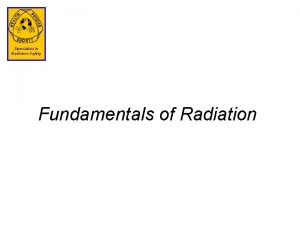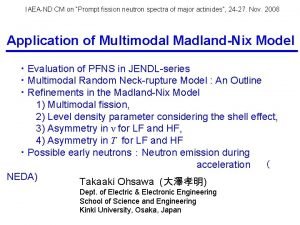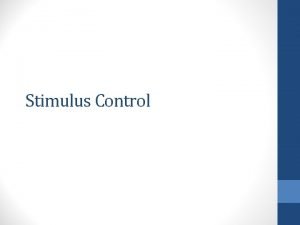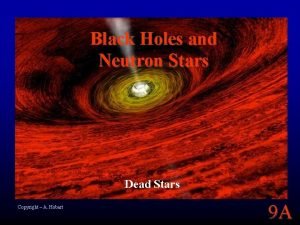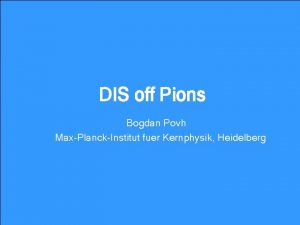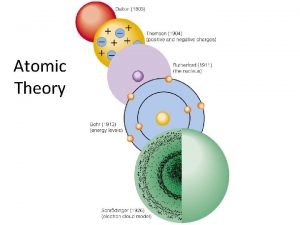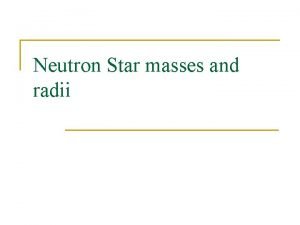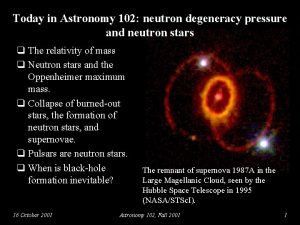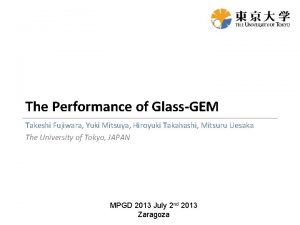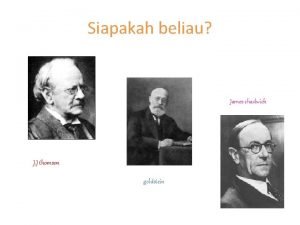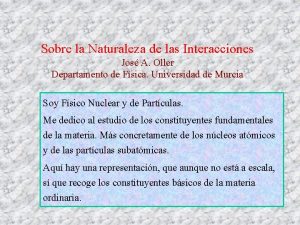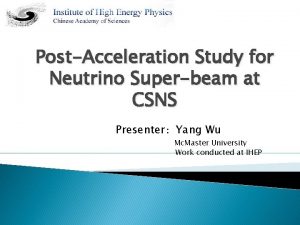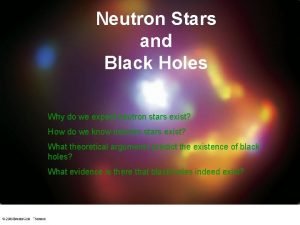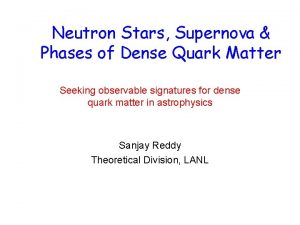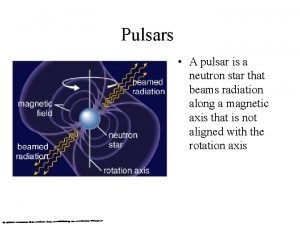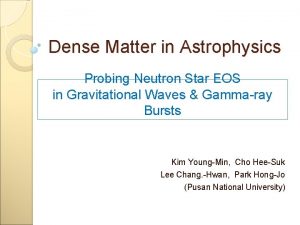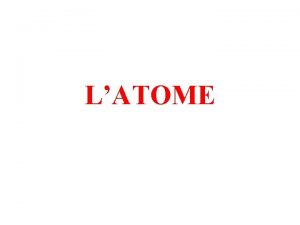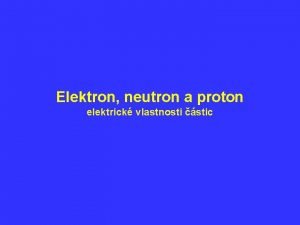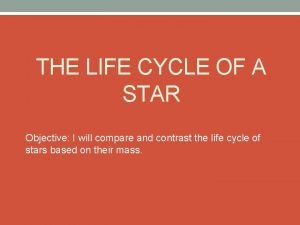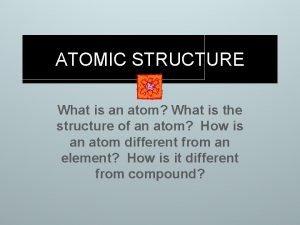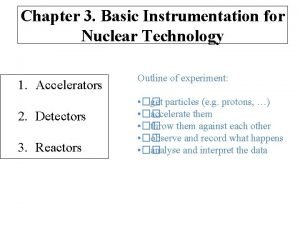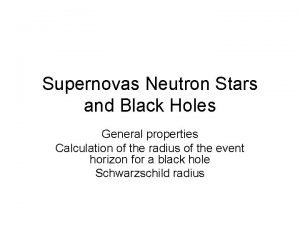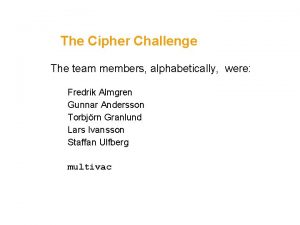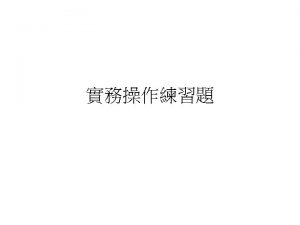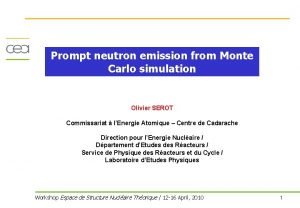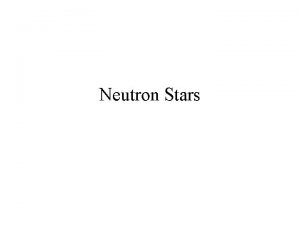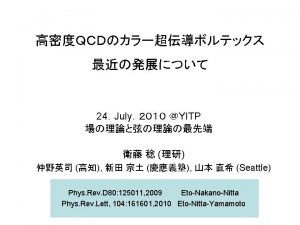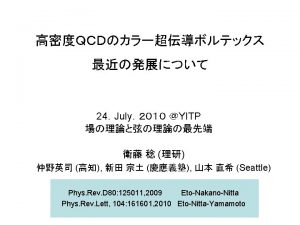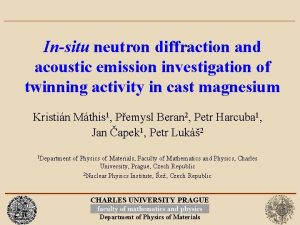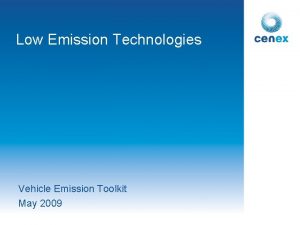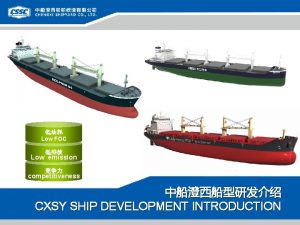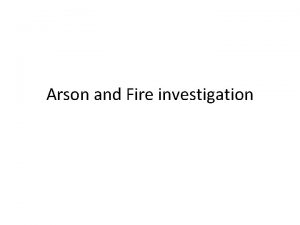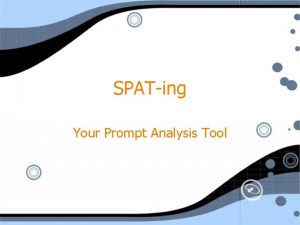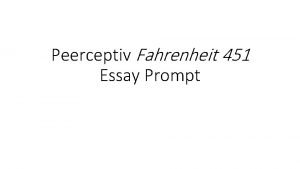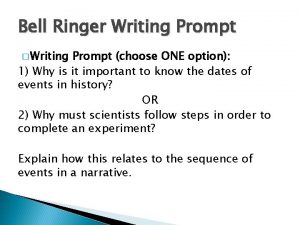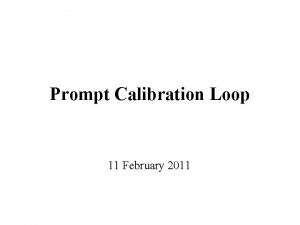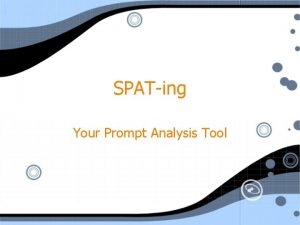Investigation of the Prompt Neutron Emission in Low

































- Slides: 33

Investigation of the Prompt Neutron Emission in Low Energy Fission of 235 U Vorobyev A. S. , Shcherbakov O. A. , Petrov G. A. Petersburg Nuclear Physics Institute. 188300, Gatchina, Leningrad district, Russia E-mail: alexander. vorobyev@pnpi. spb. ru

Motivation • Investigation of the prompt neutron emission mechanism. • Scope of the experimental data available for end-to-end analysis is limited by 1 experiment for 235 U (Skarsvag et. al. (1963)) and 3 experiments for 252 Cf (Bowman et. al. (1962), Seregina et. al. (1985), Budtz-Jorgensen et. al. (1988)). • To measure spectra of prompt fission neutrons from the 235 U(nth, f) reaction at several angles relative to the light fragment direction to eliminate the absent of these data in literature. • From previous works: the contribution of scission neutrons to the total yield of PFN ranges from 1% to 20%, so even existence of scission neutrons can hardly be considered as proven. • The 235 U is the most promising isotope for investigation as it was observed to provide the highest relative yield of supposed scission neutrons in previous experiments. 2

Methodology General features of the investigation of neutron emission mechanism: • It is well established that the main source of prompt neutrons is accelerated fission fragments ~90%; • The yield of neutrons with other emission mechanism is usually determined as difference between experimentally observable variables in the laboratory system and those calculated using known neutron spectra in the center-of-mass system; • As the prompt neutron energy spectra in the center-of-mass system of light and heavy fragments the Maxwellian or Weisskopf spectra are usually used. The parameters of these spectra are adjusted so as to show the best correlation with available experimental data. • The model of two fragments with average mass and kinetic energy is used frequently for calculation of neutron spectra in the laboratory system instead of real mass and kinetic energy distributions. Such substitution has a minor influence ( 3%) on the total neutron energy distribution. 3

Methodology D. G. Madland, IAEA Report INDC(NDS) – 251, Vienna, 1991, p. 201 4

Methodology Main features of calculation • The neutron spectra in the c. m. s of the fission fragments, nc. m. (Ec. m), are obtained using experimental data , nlab (En , lab), for 00, 180 and 360 angles relative to the fission direction free of any parameters derived from other experiments; no dependence on spectrum shape; • Using equations (two fragments approximation): nlab (En , lab) = (En / Ec. m. ) 1/2 φ(Ec. m. , c. m. ) nc. m. (Ec. m) , Ec. m. = En + Ef - 2 cos( lab ) (En Ef ) 1/2, Ef = TKE [ 1/mf – 1/A ], (Ec. m. ) 1/2 cos( cm ) = (En) 1/2 cos( lab ) – (Ef ) 1/2; • Since the fragments have the angular momenta normal to the fragment direction the angular distribution of prompt neutrons in the center-of-mass system of fission fragment may be given by: φ(Ec. m. , c. m. ) = 1 + A 2 Ec. m. (3 cos 2( c. m. ) - 1) / 2 , where A 2 = (1 - φ(1, 900) / φ(1, 00) ) 0. 5

Schematic view of the experimental set-up Reaction Chamber: 235 U target (Ø 15 mm) – 280 μg/сm 2 UF 4 onto 70 μg/сm 2 Ti backing; start MWPD (68 x 92 mm 2) 8 located within 7 mm range from the 235 U target; 6 stop MWPD (72 x 38 mm 2) located at a distance of 140 mm from the chamber axis. 5 Neutron detectors: 1 7 2 3 4 4 5 stilbene crystals (50 x 50 mm 2 and 40 x 60 mm 2 mounted on the Hamamatsu - R 6091) neutron registration threshold – 150 200 ke. V; double-discrimination method – pulse shape and time-of-flight criteria time-of-flight distance from 235 U target – ~ 50 cm 3 6 2 7 1 8 6

Raw experimental data: counts rate of fission fragments from different fragment detectors Number of registered fission events as a function of MWPDs pulse timing delay from both ends of Arc N 1 7

Raw experimental data: fission fragments time-of-flight (a) fission fragments time-of-flight spectrum detected by second MWPD of Arc N 1 (wasn’t shaded by start MWPD) (b) number of fragments as a function of TOF difference for fragments registered by two opposite detectors of Arc N 1 and N 2 8

Raw experimental data: neutron - - quanta separation method Both integrals were measured for pulse of neutron detector in a time window of 300 nsec, while the partial integral window – with a delay ~30 nsec. 9

Raw experimental data: total prompt neutron time-of flight spectrum 10

Measurement of the Total Prompt Neutron Spectrum of 235 U(nth, f) Relative to 252 Cf(sf) (neutron detector efficiency determination) 252 Cf target placed into the experimental set-up in place of 235 U

Analysis first approximation where is the angle between the neutron direction and the direction of motion of the light fragments, of T is the flight time in nanoseconds, c is the velocity of light, l is the flight path between source and the detector; is linear interpolation of the 252 Cf prompt neutron spectrum evaluation (C. W. REICH, W MANNHART, T ENGLAD – ENDF-B/VII). 12

Analysis degree of reliability – experimental errors determination • For 11 fixed angles between the neutron and light fragment direction (from 00 to 1800 in 180 interval) the prompt neutron spectra were obtained independently for two neutron detectors as weighted averages of 4 measurement cycles; • Each measurement cycle was analyzed separately • The errors of 235 U spectra for fixed angle neutron emission relative to the light fragment direction are the RMS deviation from weighted means. These errors include the possible instability of electronic (uncertainties of neutron threshold determination …), the statistical and energy determination uncertainties as well as for total prompt neutron spectrum uncertainties due to the fact that in the measurements we have the experimental histogram distributions instead of continuous distributions. • Result is a weighted average of two neutron spectra obtained by individual detectors. • The errors of 252 Cf spectra measurements were obtained as in the case with 235 U. 13

Total prompt neutron spectra first approximation ü There is a good agreement between spectra obtained by two individual neutron detectors 14

Total prompt neutron spectra first approximation ü There is a good agreement between spectra obtained by two individual neutron detectors 15

Analysis second approximation – experimental resolution was taken into account 16

Analysis second approximation: neutron energy resolution Resolution function is supposed to be Gaussian in every energy point. 17

Analysis second approximation: neutron energy resolution correction Ratio of corrected to non-corrected neutron energy spectra. 235 U 252 Cf 18

Analysis second approximation: angular resolution function calculated using the real dimensions of fragment and neutron detectors 19

Analysis second approximation: angular resolution correction Ratio of corrected to non-corrected neutron energy spectra. 235 U 252 Cf 20

Analysis second approximation: total resolution corrections 21

Analysis degree of reliability – experimental and systematic errors 22

Results: total prompt neutron spectrum of 235 U(ntn, f) comparison to literature data Present experiment : < > = 2. 44 ± 0. 05 ENDF/B-VII: < > = 2. 421 The obtained PFNS agrees with literature experimental data in full energy range 23

Results: total prompt neutron spectrum of 235 U(ntn, f) comparison to evaluation Method 1 – summation over angles; Method 2 – calculated in a framework of neutron emission from accelerated fragments using the c. m. s. spectra for light and heavy fragments obtained from experimental spectra measured at small angles relative to fragment direction in the lab. system. 24

Results: total prompt neutron spectrum of 235 U(ntn, f) Conclusion: • • • Our PFNS agrees with differential experimental data in full energy range. Results of two different measurements are in a good agreement. The average of two measurements is in a good agreement ENDF/B-VII. 25

Angle and Energy distributions of the Prompt Fission Neutrons of 235 U(n, f)

Analysis of the data Applied corrections for **: • time uncertainties in TOF measurements; • neutron detector background (a double-discrimination method, true coincidence subtracted and the linear approximation of the remain part of background); • fission fragment detector efficiency; • complementary fission fragment contribution; • angular and neutron energy resolution; • neutron detector efficiency determined as the ratio of the measured total neutron spectrum of 252 Cf to the reference standard spectrum; • normalization to the average fission neutron multiplicity of 235 U recommended by ENDF/B-VII; ** - Measurements of angular and energy distributions of prompt neutrons from thermal neutron-induced fission A. S. Vorobyev, O. A. Shcherbakov, Yu. S. Pleva, A. M. Gagarski, G. V. Val’ski, G. A. Petrov, V. I. Petrova, T. A. Zavarukhina, NIM A 598 (2009) 795 27

Analysis of the data Calculation procedure • At the first step, the neutron energy spectra in c. m. s are calculated on the assumption that neutrons registered at fixed angles relative to light fragment direction were emitted solely by the light and heavy fragments, respectively; • At the second step, the neutron contribution to the complementary fragment is subtracted and the energy spectra for these angles in the laboratory system are obtained; • Further, using these energy spectra in the laboratory system, the neutron energy spectra for light and heavy fragments are obtained in the center-of-mass system; • Finally, the spectra obtained in the center-of-mass system are used for calculation of neutron angular and energy distributions in the laboratory system. 28

Results U-235: yield of prompt neutrons as a function of angle relative to the direction of light fission fragment in the lab. system 29

Results U-235: angular distribution of the average prompt neutron emission energy in the lab. system 30

Results U-235: total prompt neutron spectra in the laboratory system 31

Conclusion • • • The angular and energy distributions of the prompt fission neutrons of 235 U(n , f) have been measured in neutron energy range 0. 2 – 12 Me. V. th Total prompt fission neutron spectrum of 235 U is in a good agreement with ENDF/B-VII. Comparison of experimentally obtained angular and energy distributions of prompt neutron for 235 U and calculated ones on the base of neutron evaporation from accelerated fragments enables: to estimate the contribution of “scission” neutrons as not to exceed 5% of total neutron yield in an assumption of isotropic evaporation in the laboratory system; • • • to conclude that the angular anisotropy of the neutron emission in the fragment center-of–mass system, which is alike to 1 + 0. 06 Ec. m. cos 2( c. m. ), should be included into any calculation of prompt neutron properties in the nuclear fission Now we are doing the same analysis of the measured angle-energy distributions of 233 U(nth, f). In future we are planning to carry out the same experiment for 239 Pu(nth, f). 32

Thank you very much for your attention 33
 Beta decay
Beta decay Proton capture equation
Proton capture equation Neutron emission
Neutron emission Response prompt vs stimulus prompt
Response prompt vs stimulus prompt Response prompt vs stimulus prompt
Response prompt vs stimulus prompt Ultra low emission burner
Ultra low emission burner High precision vs high accuracy
High precision vs high accuracy Low voltage hazards
Low voltage hazards Mid = low + (high - low) / 2
Mid = low + (high - low) / 2 Reflective communication style
Reflective communication style Neutron degeneracy pressure
Neutron degeneracy pressure Dis off
Dis off Which scientist discovered neutron
Which scientist discovered neutron Neutron star
Neutron star Photon neutron
Photon neutron Neutron degeneracy pressure definition
Neutron degeneracy pressure definition Takeshi fujiwara
Takeshi fujiwara Siapakah penemu proton
Siapakah penemu proton Particleadventure
Particleadventure Spallation neutron source
Spallation neutron source Comic relief in macbeth act 1
Comic relief in macbeth act 1 Neutron star
Neutron star Neutron star
Neutron star Neutron star
Neutron star Neutron star
Neutron star Proton neutron
Proton neutron How to determine number of protons
How to determine number of protons Elektron proton neutron
Elektron proton neutron White dwarf neutron star black hole
White dwarf neutron star black hole Mass of neutron
Mass of neutron Neutron life cycle
Neutron life cycle Neutron superhighway
Neutron superhighway Gravitational radius
Gravitational radius Cipher neutron
Cipher neutron
